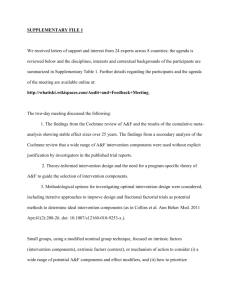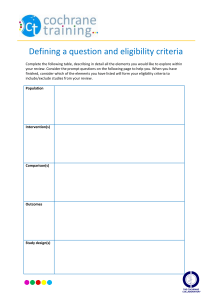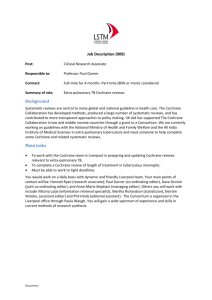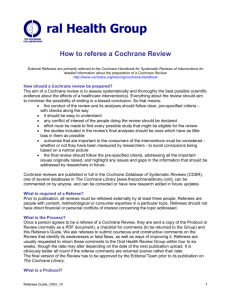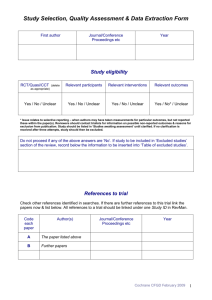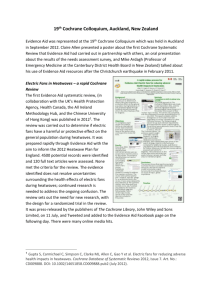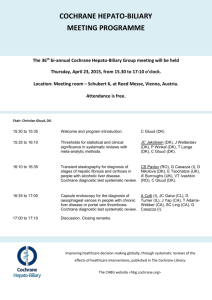Guidelines for consumer referees
advertisement
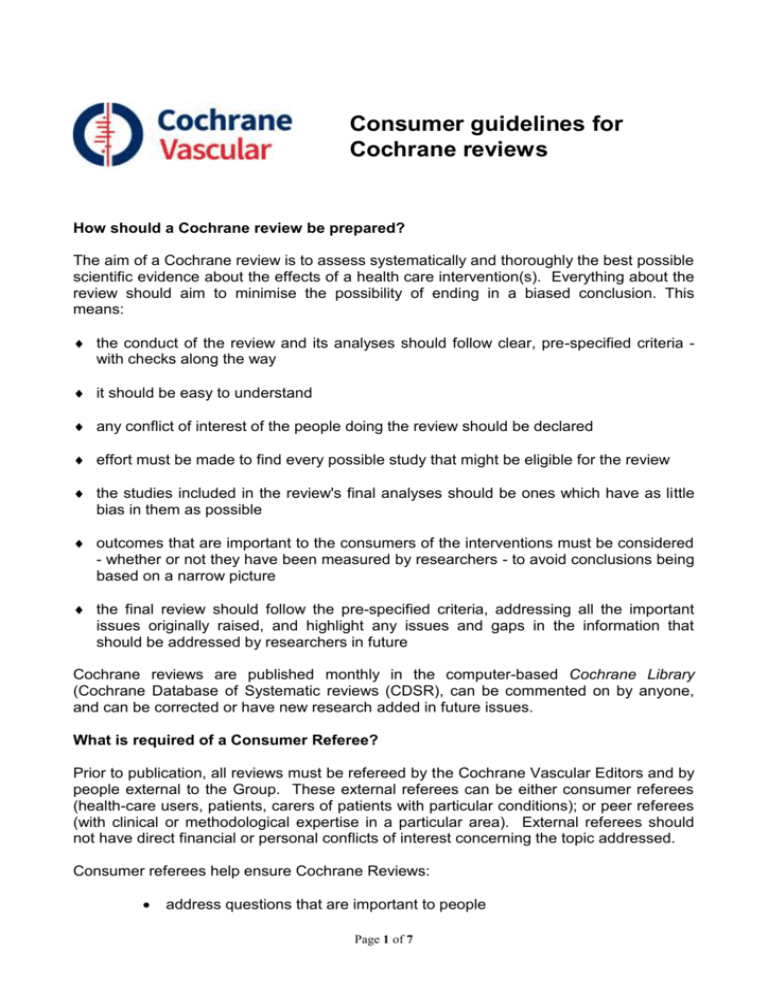
Consumer guidelines for Cochrane reviews How should a Cochrane review be prepared? The aim of a Cochrane review is to assess systematically and thoroughly the best possible scientific evidence about the effects of a health care intervention(s). Everything about the review should aim to minimise the possibility of ending in a biased conclusion. This means: the conduct of the review and its analyses should follow clear, pre-specified criteria with checks along the way it should be easy to understand any conflict of interest of the people doing the review should be declared effort must be made to find every possible study that might be eligible for the review the studies included in the review's final analyses should be ones which have as little bias in them as possible outcomes that are important to the consumers of the interventions must be considered - whether or not they have been measured by researchers - to avoid conclusions being based on a narrow picture the final review should follow the pre-specified criteria, addressing all the important issues originally raised, and highlight any issues and gaps in the information that should be addressed by researchers in future Cochrane reviews are published monthly in the computer-based Cochrane Library (Cochrane Database of Systematic reviews (CDSR), can be commented on by anyone, and can be corrected or have new research added in future issues. What is required of a Consumer Referee? Prior to publication, all reviews must be refereed by the Cochrane Vascular Editors and by people external to the Group. These external referees can be either consumer referees (health-care users, patients, carers of patients with particular conditions); or peer referees (with clinical or methodological expertise in a particular area). External referees should not have direct financial or personal conflicts of interest concerning the topic addressed. Consumer referees help ensure Cochrane Reviews: address questions that are important to people Page 1 of 7 take account of outcomes that are important to those affected are accessible to people making decisions reflect variation in the values and conditions of people and healthcare in different countries. What is the process? Once a person agrees to be a consumer referee for a Cochrane Review, they are sent a copy of the review or protocol, a checklist for comments (to be returned to the Group) and this external referee guide. We ask external referees to submit courteous and constructive comments on the review that identify its weaknesses or fatal flaws, as well as ways of improving it. External referees are usually requested to return these comments to the Review Group within two or three weeks. You may not want to comment on all the sections of the protocol or review. There are other people asked to referee, these include clinicians, researchers and methodologists. You have been chosen for your specific expertise and views as a consumer. The final version of the review will be approved by the editorial team prior to its publication on the Cochrane Library. The refereeing process is not anonymous. Comments and criticisms by consumer and peer referees and the Cochrane Vascular editorial team are sent to the authors with the names of their originators attached, unless specifically requested not to. What is a protocol? A Cochrane protocol is published prior to the review and provides a blue-print of what will be contained in the final review. The purpose of a protocol is to promote transparency of methods and processes and to reduce both duplication and the potential of bias. What is a review? A review follows the strategy and methods outlined in the protocol, and assesses systematically and thoroughly the best possible scientific evidence about the effects of a health care intervention(s). Guidelines for Sections of the Protocol (Note: little should have changed between the protocol stage and the review stage in terms of the following sections): Title The name of the review should properly reflect the subject of the review, and it should be easy to understand. Background This should explain the topic being reviewed, and the intervention(s) of interest. background should make the motivation and rationale for the review clear. background section is designed to explain to people what is going to be reviewed why. The review authors must explain why the question asked is important to answer. Page 2 of 7 The The and For example, it should indicate the areas of uncertainty in relation to the intervention and highlight issues that are controversial or the subject of public concern. All terms and interventions must be clearly defined, and the background must use a balanced tone that does not pre-judge the value of the intervention. The background should be brief. It is not a monograph or an overview and should be concise and clear. Objective This should have a precise statement of the primary objective of the review, including the intervention(s) reviewed and the problem addressed. It can also mention why the review is being done, and how it might relate to a wider review of a general problem. If there are hypotheses for the review (specific theories or suggestions being tested), these should be stated here. The comparisons that are listed later in the review should be consistent with any hypotheses described here. Selection criteria This section has several parts. Together, they should make it clear which studies can be included in the review, and which will not be eligible. The aim is to come up with very specific guidelines for deciding whether a study addresses the objective of the review. This section is supposed to make the reasons for including a study so clear, that anyone else can come along, apply the criteria, and come to more or less the same decisions. Later, the quality of studies that make it past this first test will also be assessed. This section includes: Type of participants: This needs to state which groups of people can be included in any studies. For example, some reviews might be looking only at children or people over a particular age. Or they might be looking only at people with a specific disease, of a particular severity (for example, a particular level of high blood pressure). Type of interventions: An intervention is anything that is meant to change the course of events for someone. Surgery, a drug, a test, a treatment, counselling, giving someone a pamphlet - all of these are interventions. Type of outcomes: The outcomes that the reviewers are going to look for in each study should be listed here. This should include all the most important outcomes which need to be considered to make decisions about the particular intervention. These need to be specified ahead of time. The studies may not address particular outcomes - in which case it is important for the review authors to know that important topics have been overlooked. If an outcome is an important key to understanding or assessing the impact of an intervention, this needs to be stated now. Coming up with theories about outcomes later does not have the same scientific strength. Type of studies: This specifies the design of the studies that will be eligible - usually controlled trials. The aim is to include study designs which minimise the chances of the results being biased. Bias is something that introduces a difference or trend that distorts (or could distort) the results. Bias is a systematic error that will run through the study, Page 3 of 7 because what is observed may not be the effect of the intervention, but an effect of bias instead. An example is when everybody knows they have received a new “breakthrough” treatment - just knowing that might make people feel better, while the people who “missed out” might be very dissatisfied and feel worse because of it. Search strategy for the identification of studies This section shows how and where the reviewers will find trials eligible for the review. The write-up of this section should include the databases that will be searched and the other methods that are used to find trials. Cochrane Vascular suggests that several of the main databases are searched as well as those which may be particularly relevant to the topic of the review. It is also recommended that additional searching includes such methods as checking through the lists of references of relevant articles and books, checking through the proceedings of conferences that present research results, personal contact with experts or institutions that could have relevant material and a search for grey literature. Any journals to be hand-searched (that is, looking through all the copies of the journals) should also be listed. Cochrane reviews are meant to try and identify both published and unpublished studies. Methods This section should spell out the steps of the review - who did what, and according to what standards and criteria. Authors need to outline how they will decide which studies are eligible for consideration, how they decide which studies to include and to exclude, how they decide on whether studies were done well enough or not to be included in the Review. The way the quality of studies will be assessed should be outlined. As with the selection criteria, the aim is to be so clear and specific that someone else applying the same methods would come up with more or less the same results. The review authors should include what statistical methods will be used, and any sensitivity or subgroup analyses that may be carried out. In the review, any deviations from the stated plans in the protocol should be justified and outlined. It is more reliable to have established reasons for differences that may be in the data before the analysis is done and then test these hypotheses than to imagine reasons for observed differences after the analysis has been undertaken. We would also like authors to outline how they have considered consumers’ views and any consumer participation within the methods section of their review. Conflict of interest Review authors should report here any conflict of interest capable of influencing their judgments, including personal, political, academic, and other possible conflicts particularly financial. It is impossible to abolish all conflict of interest, since the only person who does not have some vested interest in a subject is somebody who knows nothing about it at all, and who cannot be affected in any way. However, any interest that Page 4 of 7 could unduly influence judgments in a review (such as deciding which studies can stay in, or what the results mean) needs to be declared. Financial conflicts of interest in particular need to be declared. This includes the receipt of any benefit in cash or kind, any hospitality, or any subsidy derived from any source with an interest in the results of the review. Any sponsorship or funding of the review needs to be declared. If there are no conflicts of interest, this should be stated explicitly e.g., by reporting ‘None known’. NOTE: For all sections above there should be NO CHANGES FROM THE PROTOCOL STAGE except that the tense changes from FUTURE TENSE to PAST TENSE, ie. The protocol describes what WILL be done. The review describes what WAS done. Any deviation from the protocol plan should be clearly outlined and justified. The Review adds several sections to the protocol, outlined below: Description of studies This should refer to the information contained in the ‘Characteristics of Included Studies’ and the ‘Characteristics of Excluded Studies’ tables. It should describe key characteristics of the study participants, interventions and outcome measures in the included studies and any important differences among the studies. The sex and age range of participants should be stated here unless it is obvious (e.g. if all the participants are pregnant). Reviewers should note any other characteristics of the studies that they regard as important for readers of the review to know. Methodological quality of included studies This should describe the general quality of the included studies and any important flaws in individual studies. If the quality of each study was assessed using explicit criteria, the criteria that were used should be described or referenced under ‘Methods’. How each trial scored on each criterion can be summarised in this section or, preferably, included in the ‘Characteristics of Included Studies’. Results This should be a summary of the main findings of the review, including subgroup analyses and any sensitivity analyses that were undertaken. Subheadings can be used if they make reading easier (e.g. for each prior hypothesis if a review addresses more than one). The results of individual trials, and any statistical summary of these, should be included and refereed to in ‘Data Tables’. Review authors should avoid making inferences or drawing conclusions in this section. A common mistake to avoid (both in describing the results and in drawing conclusions) is the confusion of 'no evidence of an effect' with 'evidence of no effect'. Discussion This should include brief comments on any methodological limitations of the included studies and the review that are important for decisions about practice or future research. Comments on how the included studies fit into the context of other evidence might be Page 5 of 7 included here, stating clearly whether the other evidence was systematically reviewed. Comments on how the results of the review fit into the context of current clinical practice might be included here, although review authors should bear in mind that current clinical practice might vary internationally. Reviewers’ conclusions The primary purpose of the review should be to present information, rather than to offer advice. Implications for practice and Implications for research are subheadings in this section. The implications for practice should be as practical and unambiguous as possible. They should not go beyond the evidence that was reviewed. ‘No evidence of effect’ should not be confused with ‘evidence of no effect’. The implications for research should not include vague statements such as ‘more research is needed’. Reviewers should state exactly what research is needed, why and how urgently. Opinions on how the review might be improved with additional data or resources might also be included here. Acknowledgements This section should be used to acknowledge any individuals or organisations that the reviewers wish to acknowledge but who have not made a sufficient contribution to the review to be included in the Contributions section. We encourage reviewers to acknowledge the contribution of Cochrane Vascular editors and staff. Tables and Figures Characteristics of included studies: This is a standard table with seven columns: study ID, methods, participants, interventions, outcomes, notes and allocation concealment. The table requires standard and consistent presentation of data for each trial. Reviewers must decide what characteristics of the included studies are likely to interest users of the review. It is possible to use codes so that each column can include several subcategories of information; e.g. a reviewer could include country, setting and sex under ‘participants’. Information on the funding of a study could be included under ‘notes’. Footnotes should be used for explanations of any abbreviations used (these will be published in the CDSR). Reviewers must also include information about the ‘Data source’ for all included studies to indicate whether published data only, unpublished data only or a mixture were used, or if unpublished data were sought but have not been used (e.g. because they have not been obtained). Characteristics of excluded studies: Any studies not meeting the inclusion criteria, or appearing not to meet the inclusion criteria, that were excluded should be identified and the reason for exclusion should be given (e.g. inappropriate control group). Characteristics of ongoing studies: This is a standard table with seven columns: Study ID, Trial name or title, Participants, Interventions, Outcomes, Starting date, Contact information and Notes. Footnotes should be used for explanations of any abbreviations used in the table (these will be published in the CDSR). Comparisons and data: A review can include more than one comparison and a study can be included in more than one of these. The comparisons should correspond to the questions or hypotheses under ‘Objectives’. Data for each comparison must be entered in a standardised format from which tables and figures for each comparison can be generated. Reviewers should try to avoid listing many comparisons or outcomes for which Page 6 of 7 there are no data in the review since each comparison generates a graph even if it contains no data and analysis. Instead, reviewers should note these comparisons in the text of their review. Four types of tables are possible: dichotomous data, continuous data, individual patient data and other data. References: References for every article or book identified in the text need to be listed. Style of writing: The text of the review should be clear, concise and to the point. It should be written so that someone who is not an expert in the area can understand it. Page 7 of 7


